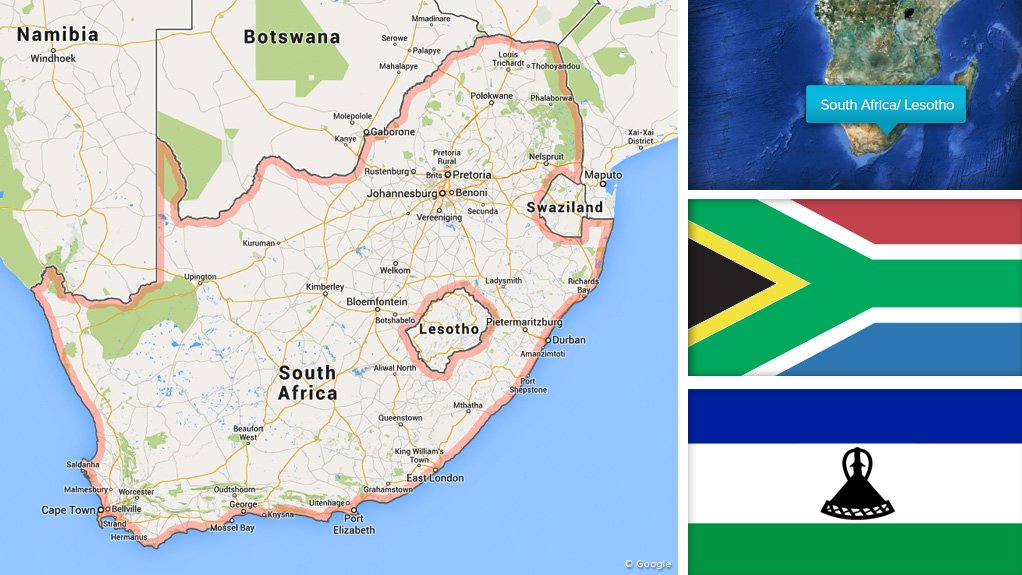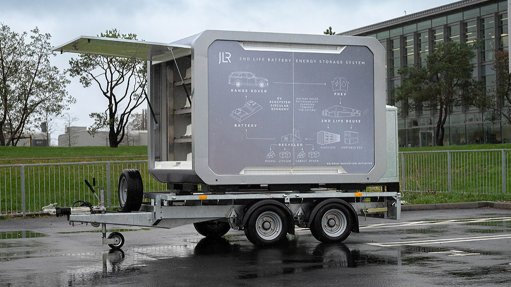Lesotho Highlands Water Project – Phase II
Name of the Project
Lesotho Highlands Water Project (LHWP) – Phase II.
Location
Lesotho and South Africa.
Client
The Lesotho Highlands Development Authority (LHDA) and the Trans-Caledon Tunnel Authority (TCTA) are the implementing authorities.
The Lesotho Highlands Water Commission has an oversight function, advises the two governments and monitors the activities of the LHDA and TCTA.
Project Description
Phase I of the LHWP was officially completed in 2004.
Phase II of the LHWP will be implemented in terms of two distinct components: a water delivery system to augment the delivery of water to South Africa and a hydropower generation system.
Polihali dam
The Polihali dam will be built downstream of the confluence of the Senqu and Khubelu rivers and will be a 163.5-m-high concrete-faced rockfill embankment dam wall.
The crest length will be 915 m, with a full supply level of 2 075 m above sea level. A 49.5-m-high saddle dam and a side channel spillway will also be built.
Polihali to Katse tunnel
The 38.2-km-long, 5-m-diameter Polihali-to-Katse dam tunnel will be constructed to transfer water from the Polihali reservoir to the Katse reservoir.
Water will be abstracted from the Polihali reservoir through two separate concrete bell-mouth intakes on the western side of the Polihali reservoir, in the Khubelu river, 3 km upstream of the confluence with the Senqu river.
Water will be transferred through the lower and upper intake tunnels to the intake gate shaft. Both tunnels will be constructed using drill-and-blast methods and will be fully concrete-lined. Hydraulic control will be effected by the valves in the intake structures.
The Polihali intake gate shaft will be used only for maintenance and water-quality control functions.
Advance infrastructure
Where possible, the existing infrastructure constructed in Phase I will be used. This includes access roads, power supply, telecommunication systems and camps.
Significant additional works contracts will be awarded for the construction of all-weather access roads, a bulk power supply network, telecommunications systems and project housing, as well as labour camps, on both ends of the transfer tunnel.
A permanent housing development will be established near the Polihali dam and transfer tunnel, which will consist of project offices, and residential and community facilities.
This will require extensive infrastructure development before the mobilisation of contractors for the two main works contracts of the Polihali dam and transfer tunnel.
The Polihali intake site will use the infrastructure required to construct the Polihali dam and the transfer tunnel. This includes feeder roads and bridges around the reservoir to connect affected communities, power supply systems, construction camps and communications.
The facilities at Katse dam will be used for the Polihali-to-Katse tunnel construction. Existing facilities will be used to house consultants and construction management teams. Improvements to the water and sewage treatment plants, clinic and lodge will be undertaken.
Other infrastructure
In addition to the main access roads, to service the construction phase, other access and feeder roads will be constructed around the reservoir to connect affected communities using pedestrian and light-vehicle bridges, while a pair of major road bridges will be built over the Polihali reservoir at Tlhakola, crossing the Khubelu river, and near Mokhotlong, crossing the Senqu river.
Environmental measures
Environmental mitigation measures, including environmental flow matters and baseline studies, will be implemented.
The full extent is being studied in detail for implementation.
An environmental and social management programme is being implemented to address potential environmental and social impacts associated with Phase II activities.
The programme comprises baseline studies, including those pertaining to environmental flow requirements, biological and archaeological (including heritage) studies, as well as socioeconomic and public health studies.
The programme also includes environmental- and social-impact assessments (ESIAs), and the implementation of the subsequent environmental and social management and action plans.
Social development programmes
These programmes, mitigation measures, resettlement requirements and baseline studies, as well as public relations and awareness campaigns, will be implemented.
The full extent of these measures are being studied and discussed.
Infrastructure developments might include clinics, feeder roads and bridges around the reservoir to connect affected communities, and social development projects such as schools, churches and community halls.
The above will be informed by the outcome of the baseline studies, as well as the sustainable development programmes to be designed.
Pumped-storage scheme
Phase II might also include a pumped-storage scheme, associated transmission lines and works using the existing Katse reservoir as the lower reservoir, and a new upper reservoir in the Kobong Valley.
The exact form of the hydropower component is still to be agreed on by the governments of South Africa and Lesotho. The decision will be informed by further feasibility studies, with a request for proposals (RFPs) having been issued for the additional studies required.
Jobs to be Created
Not stated.
Value
As of November 2015, the estimated cost of the Phase II water transfer component was R22.9-billion at completion.
Duration
The development has been materially delayed from its initial 2020 completion date and is currently expected to be operational only in 2025.
Latest Developments
The LHDA has reported that the engineering design contracts for the two main water-transfer components of the Lesotho Highlands Water Project Phase II will be awarded by mid-2017 and that construction should begin 18 months thereafter.
The project is currently expected to be operational only in 2025.
The delay has been attributed to postponements in the ratification, in South Africa and Lesotho, of a 2011 Phase II agreement, as well as to several delays in finalising key policies, including the procurement policy. The deferral has been heavily criticised, particularly as the effects of South Africa’s worst drought in a generation have become apparent.
LHDA Phase II divisional manager Tente Tente has acknowledged in an interview with Engineering News Online that progress has been slower than initially anticipated. However, he has expressed confidence that the political, legal, policy, environmental and funding frameworks are now in place to support project implementation.
Several contracts for the design of associated infrastructure, such as roads, power lines, housing and village relocation, have been awarded, and the focus at the LHDA is currently shifting to the core water-transfer and hydropower contracts.
The deadline for responses to a RFPs for the Polihali dam was December 5, with four professional services joint ventures (JVs) having been shortlisted during a prequalification phase for the design and construction supervision of the dam.
The deadline for a separate RFP for the professional services for the design and construction supervision of the Polihali transfer tunnel is January 9, 2017. Nine applicants participated in the prequalification phase, with three consortiums shortlisted to participate.
“The dam will be completed ahead of the tunnel,” Tente has said, adding tunnel boring machines will probably be employed at either end of the tunnel to accelerate construction.
He has argued that the groundwork is at last in place to ensure project progress.
“It’s not all doom and gloom,” he has added, while acknowledging the prevailing frustrations over the project’s delay.
He is convinced that, once the contracts are placed for the dam and the tunnel, the pace will accelerate and the revised timeframes will be met.
“Once the professionals are appointed, they will start to dictate the pace,” he has asserted, adding that the designs for the dam and tunnel should be finalised by mid-2018. The construction phase is expected to begin in earnest during 2019.
Particular attention is being given to the relocation of the 2 500 people affected by the dam construction.
A total of 530 houses across 17 villages will be affected and Tente has said that every effort will be made to ensure that the relocation effort is handled with “sensitivity”. Consultations with affected communities will intensify during 2017 and relocation compensation has been fully factored into the project budget.
Progress, he adds, is also being made on the 1 200 MW hydropower component, with a feasibility study scheduled for completion in mid-2018. The World Bank is providing grant funding and a consultant has been appointed to finalise the study, including whether the proposed pumped-storage scheme at Kobong is the best option.
“Once the study is completed, there will be a design phase and we expect to start construction in 2021. When the first water flows into South Africa in 2025, the hydro will be ready for commissioning,” Tente has said.
Key Contracts and Suppliers
Maleka, Ntshihlele, Putsoa JV (reservoir demarcation); Jeffares & Green, in association with GWC Consulting Engineers (geotechnical engineers); SMEC-FMA JV (Polihali north-east access road – consultant) and Polihali Infrastructure Consultants, a JV between Mott MacDonald PDNA and Khatleli Tomane Moteane (planning, design and construction supervision of the housing and associated infrastructure – Phase II).
On Budget and on Time?
Water delivery is expected to begin in 2024, based on the current project programme.
It is too early to comment on the hydropower component, as it is being subjected to feasibility studies and its exact form is still to be determined.
Contact Details for Project Information
LHDA responsible manager – divisional manager Phase II Tente Tente, tel +266 222 46000 or email tentet@lhda.org.ls.
LHDA public relations manager Masilo Phakoe, tel +266 2224 6000 or email phakoem@lhda.org.ls.
Comments
Announcements
What's On
Subscribe to improve your user experience...
Option 1 (equivalent of R125 a month):
Receive a weekly copy of Creamer Media's Engineering News & Mining Weekly magazine
(print copy for those in South Africa and e-magazine for those outside of South Africa)
Receive daily email newsletters
Access to full search results
Access archive of magazine back copies
Access to Projects in Progress
Access to ONE Research Report of your choice in PDF format
Option 2 (equivalent of R375 a month):
All benefits from Option 1
PLUS
Access to Creamer Media's Research Channel Africa for ALL Research Reports, in PDF format, on various industrial and mining sectors
including Electricity; Water; Energy Transition; Hydrogen; Roads, Rail and Ports; Coal; Gold; Platinum; Battery Metals; etc.
Already a subscriber?
Forgotten your password?
Receive weekly copy of Creamer Media's Engineering News & Mining Weekly magazine (print copy for those in South Africa and e-magazine for those outside of South Africa)
➕
Recieve daily email newsletters
➕
Access to full search results
➕
Access archive of magazine back copies
➕
Access to Projects in Progress
➕
Access to ONE Research Report of your choice in PDF format
RESEARCH CHANNEL AFRICA
R4500 (equivalent of R375 a month)
SUBSCRIBEAll benefits from Option 1
➕
Access to Creamer Media's Research Channel Africa for ALL Research Reports on various industrial and mining sectors, in PDF format, including on:
Electricity
➕
Water
➕
Energy Transition
➕
Hydrogen
➕
Roads, Rail and Ports
➕
Coal
➕
Gold
➕
Platinum
➕
Battery Metals
➕
etc.
Receive all benefits from Option 1 or Option 2 delivered to numerous people at your company
➕
Multiple User names and Passwords for simultaneous log-ins
➕
Intranet integration access to all in your organisation





















